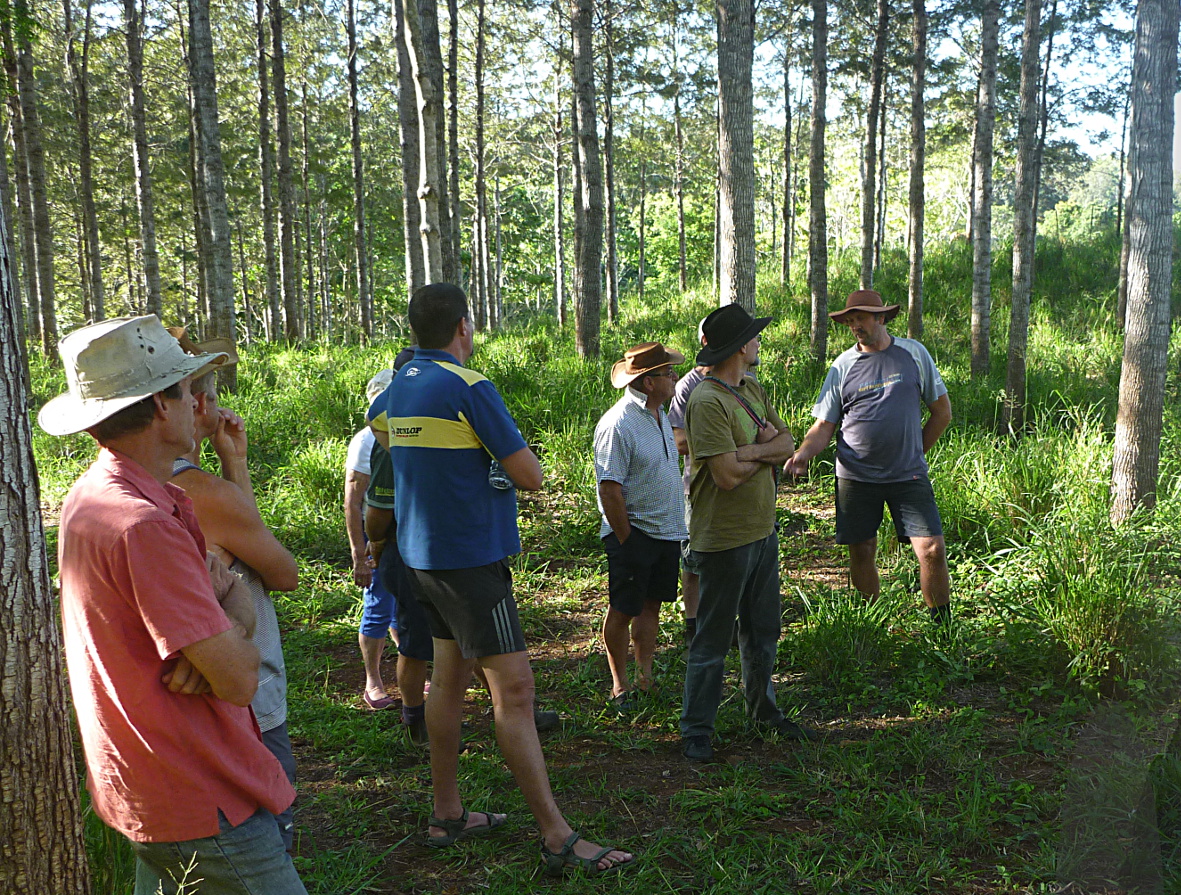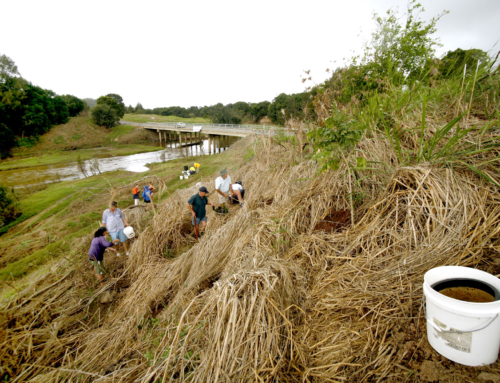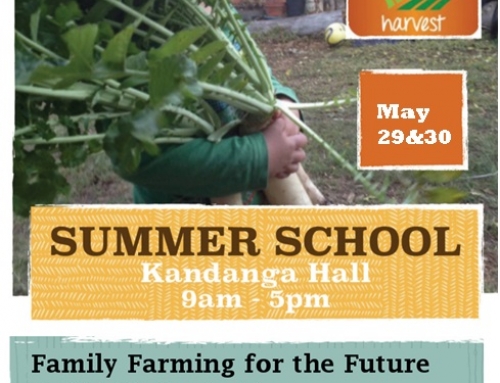On the 25th May, a dozen or so locals spent a glorious autumn Sunday afternoon looking at the results of land rehabilitation work by landowners around Dagun over the last twenty years or so. It was an opportunity to look at some of the main land degradation issues in the area, and learn what seems to have worked and what hasn’t worked in efforts to rehabilitate these areas. The farms we looked at were on steep softwood scrub (rainforest) country with very deep, red soils which had been cleared first for timber then farmed for bananas and pineapples, until these crops had become unprofitable between 50 and 10 years ago. Major landslips occurred on two of these properties following the 1974 cyclone and floods. Interestingly, the remnant vegetation around two of the watercourses(Dagun Gully and Moorehouse Gully), which flow into Amamoor Creek contains a significant native population of wild Macadamia trees which are an important genetic resource for the world’s Macadamia industry.
First stop was at Kent and Christine McClintock’s property on the northern slopes of a hill known locally as Little Baldy, which drains to Dagun Gully. Kent showed us the work that was done in the early 1990’s to rehabilitate a large landslip area which had been unusable since 1974. In the mid ‘90s the area was bulldozed to make it more accessible to machinery, and then planted up with a range of timber species. The area now has a good stand of mixed softwood timber species, and provides very useful grazing underneath.
Attempts at establishing hardwood eucalypt species were not successful at this site, mainly due to constant predation from wallabies, but ‘scrub’ cabinet timber species have done well. The most successful plantings have been silky oak and Qld maple, although local flindersia species (bumpy ash and crows ash) and white beech have also done reasonably well. Silver quandong has done well in the wetter area at near Dagun Gully, but have not done well further up the slope. Patches of local hickory wattle (acacia disparrima) did not produce usable timber due to insect attack (borers). The area has required consistent work in weed control, principally against vine pasture legumes (tinaroo glycine), and trees have been pruned to produce a good growth form for timber production. Kent does not place any economic value on the timber production in his lifetime, treating it as a possibility for future owners of the farm, depending on the economics at the time.
As a landslip area, this patch had no great value for economic production or nature conservation, and posed a risk to the creek and farm infrastructure below. In its current state, the work may have helped stabilize the slip area (unknown as yet), provides useful grazing, some natural and aesthetic values, and possibly an economic timber source in the future. Kent’s advice was that he would definitely go for a mixed species planting for this sort of purpose, rather than planting in single species blocks. He also gave good advice on the practicalities of working with machinery in such steep country, and planning the plantings and pre-plant deep ripping patterns well with safe future machinery access and erosion risk in mind from the start.
Kent then showed us the work he has done in fencing off and maintaining the remnant original lowland rainforest vegetation in Dagun Gully, with a planned cattle and vehicle crossing and access point, and small holding/quarantine paddock for cattle coming on to the property to try to prevent the spread of giant rat’s tail grass on to the property. This patch of remnant vegetation has been studied and documented, and has a very good list of rare plant, bird, fish and mammal species recorded. Kent and Christine have consistently worked with planting and enhancing the natural values of the property and see this work as an ongoing activity.
We then went to look at the work that has been done on the southern slopes of Little Baldy and Moorehouse Gully by Mick and Shelly Bryant. The Bryants have put many years of consistent long term efforts into rescuing their section of the gully and encouraging the native vegetation starting to re-establish on the ex banana growing slopes above the gully. Perhaps the main issue in Moorehouse Gully is the heavy infestations of madeira vine, cats claw creeper and elephant grass, which in most places have completely overwhelmed any remnant native vegetation.
Before looking at the results of the Bryants work, we were given a good introduction to the latest technology in bio-control agents for madeira vine and cat’s claw creeper by Jim Johnston of Gympie Landcare. Jim had brought along samples of the vines with the current biocontrol agents (tingid bugs and jewel beetles for Cats Claw, and beetle larvae for Madeira) and gave a pretty good back-of-ute talk about these weeds and current best practice for their control.
There was a lively discussion on the role of herbicide use for environmental weed control, particularly as many members of the co-op are strongly oriented towards organic food production. However, with the scale of the weed problem evident, and the relative ineffectiveness of mechanical control methods with the limited amount of labour available led to conclusion that tackling the issue required an integrated system of mechanical, chemical and biological control methods.
The most striking part of the visit to the Bryants’ section of Moorehouse gully was the contrast between the area they had replanted and cared for over the last twenty years (which had achieved impressive growth of large trees and good canopy cover over what is starting to look like a healthy rainforest stream again), and the other areas of the gully nearby which were totally choked with weeds, with little or no chance of any native vegetation re-establishing itself. However, there was still a noticeable paucity of healthy understory plants in many areas, because of the ongoing requirement for chemical control of elephant grass and madeira vine which are constantly invading from surrounding areas.
Last stop of the day gave us glorious late afternoon views over the Mary Valley from the edge of a landslip high on the ridge on John and Julia Tidy’s property. John discussed his plans for fencing and planting the area, and called for ideas to help with planning the project. The main thought was to investigate what was going on with groundwater recharge in the area above the slip, and look at what the drainage patterns were above and below the slip.
All in all these Sunday afternoon farm visits have been a useful way for people to learn from each other’s experience. We have to thank Peter and Bevley Hughes for attending and reporting these events in the local rural press, and of course many thanks go to the landholders who give up their time and privacy to help other people in this way. The next farm walk is looking at grazing and pasture management in small scale beef production.




